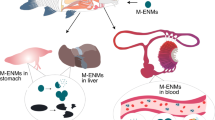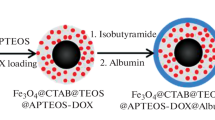Abstract
Nanomaterials are defined as the materials with any external dimension in the nanoscale or having internal structure or surface structure in the nanoscale, with nanoscale defined as the “dimensions ranging approximately from 1 nm to 100 nm.” Their characteristic feature is a high ratio of surface area to volume, which determines their unique physicochemical properties. The chapter presented is concerned with the investigation of nanomaterials containing metal atoms or compounds, known as metal-based nanomaterials (MNMs) found in biological matrices such as plant tissues or physiological substances. The presence of MNM in plant tissues is a consequence of intensive emission of MNM to the natural environment as a result of various technological processes. Investigation of MNM in physiological materials is related to the possibility of their use in diagnosis and treatment of cancer, which require characterization of MNM behavior in preclinical conditions.
The chapter presents the possibilities and limitations of techniques most often used for imaging and characterization of the forms and transformations of MNMs in biological matrices along with a review of selected experimental reports concerning this subject. MNM imaging is performed employing the microscopic, spectrometric, and spectroscopic techniques, such as laser ablation inductively coupled plasma mass spectrometry (LA-ICP-MS) and X-ray fluorescence spectroscopy (XRF). The forms and transformations of MNM in biological matrices are investigated mainly by X-ray absorption near-edge spectroscopy (XANES) but also by other spectrometric techniques as well as by a combination of mass spectrometry and separation techniques such as capillary electrophoresis (CE) and high-performance liquid chromatography (HPLC). Although MNM in biological matrices can be studied by many diverse methods, the hitherto research work in this area is of basic and incomplete character, often semiquantitative, which is a consequence of complexity of analytical procedures following from the diversity of physicochemical properties of nanomaterials and biological matrices.
Access this chapter
Tax calculation will be finalised at checkout
Purchases are for personal use only
Similar content being viewed by others
References
Journal of the European Union Law 2011/696/UE
Capaldi Arruda, S. C., Diniz Silva, A. L., Moretto, G. R., et al. (2015). Nanoparticles applied to plant science: A review. Talanta, 131, 693–705.
Lv, J., Christie, P., & Zhang, S. (2019). Uptake, translocation, and transformation of metal-based nanoparticles in plants: Recent advances and methodological challenges. Environmental Science: Nano, 6, 41–59.
Pan, B., & Xing, B. S. (2012). Applications and implications of manufactured nanoparticles in soils: A review. European Journal of Soil Science, 63, 437–456.
Kah, M., Kookana, R. S., Gogos, A., & Bucheli, T. D. (2018). A critical evaluation of nanopesticides and nanofertilizers against their conventional analogues. Nature Nanotechnology, 13, 677–684.
Ma, X. M., Geiser-Lee, J., Deng, Y., & Kolmakov, A. (2010). Interactions between engineered nanoparticles (ENPs) and plants: Phytotoxicity, uptake and accumulation. Science of the Total Environment, 408, 3053–3061.
Montes, A., Bisson, M. A., Gardella, J. A., Jr., & Aga, D. S. (2017). Uptake and transformations of engineered nanomaterials: Critical responses observed in terrestrial plants and the model plant Arabidopsis thaliana. Science of the Total Environment, 607–608, 1497–1516.
Dimkpa, C. O., Latta, D. E., McLean, J. E., et al. (2013). Fate of CuO and ZnO nano and micro particles in the plant environment. Environmental Science & Technology, 47, 4734–4742.
Wojcieszek, J., Jiménez-Lamana, J., Bierła, K., et al. (2019). Elucidation of the fate of zinc in model plants using single particle ICP-MS and ESI tandem MS. Journal of Analytical Atomic Spectrometry, 34, 683–693.
Nabil, G., Bhise, K., Sau, S., et al. (2019). Nano-engineered delivery systems for cancer imaging and therapy: Recent advances, future direction and patent evaluation. Drug Discovery Today, 24, 462–491.
Silva, C. O., Pinho, J. O., Lopes, J. M., et al. (2019). Current trends in cancer nanotheranostics: metallic, polymeric, and lipid-based systems. Pharmaceutics, 11, 22–62.
Zhou, Q., Li, Z., & Wu, H. (2017). Nanomaterials for cancer therapies. Nanotechnology Reviews, 6, 473–496.
Sharma, H., Mishra, P. K., Talegaonkar, S., & Vaidya, B. (2015). Metal nanoparticles: a theranostic nanotool against cancer. Drug Discovery Today, 20, 1143–1151.
Hu, Y., Mignani, S., Majoral, J.-P., et al. (2018). Construction of iron oxide nanoparticle-based hybrid platforms for tumor imaging and therapy. Chemical Society Reviews, 47, 1874–1900.
Guo, J., Rahme, K., He, Y., et al. (2017). Gold nanoparticles enlighten the future of cancer theranostics. International Journal of Nanomedicine, 12, 6131–6152.
De Matteis, V., Cascione, M., Toma, C. C., & Leporatti, S. (2018). Silver nanoparticles: Synthetic routes, in vitro toxicity and theranostic applications for cancer disease. Nanomaterials, 8, 319.
Kulkarni, N. S., Guererro, Y., Gupta, N., et al. (2019). Exploring potential of quantum dots as dual modality for cancer therapy and diagnosis. Journal of Luminescence, 209, 61–68.
Ivask, A., Mitchell, A. J., Malysheva, A., et al. (2018). Methodologies and approaches for the analysis of cell–nanoparticle interactions. WIREs Nanomedicine and Nanobiotechnology, 10, e1486.
Matczuk, M., Ruzik, L., Aleksenko, S. S., et al. (2019). Analytical methodology for studying cellular uptake, processing and localization of gold nanoparticles. Analytica Chimica Acta, 1052, 1–9.
Chen, D., Monteiro-Riviere, N. A., & Zhang, L. W. (2017). Intracellular imaging of quantum dots, gold, and iron oxide nanoparticles with associated endocytic pathways. WIREs Nanomedicine and Nanobiotechnology, 9, e1419.
Zahra, Z., Arshad, M., Rafique, R., et al. (2015). Metallic nanoparticle (TiO2 and Fe3O4) application modifies rhizosphere phosphorus availability and uptake by Lactuca sativa. Journal of Agricultural and Food Chemistry, 63(31), 6876–6882.
Pozebon, D., Scheffler, G. L., & Dressler, V. L. (2017). Recent applications of laser ablation inductively coupled plasma mass spectrometry (LA-ICP-MS) for biological sample analysis: A follow-up review. Journal of Analytical Atomic Spectrometry, 32, 890–919.
Sekine, R., Moore, K. L., Matzke, M., et al. (2017). Complementary imaging of silver nanoparticle interactions with green algae: Dark-field microscopy, electron microscopy, and nanoscale secondary ion mass spectrometry. ACS Nano, 11, 10894–10902.
Wang, B., Feng, W., Chai, Z., & Zhao, Y. (2015). Probing the interaction at nano-bio interface using synchrotron radiation-based analytical techniques. Science China Chemistry, 58, 768–779.
Vittori, A. L., Carbone, S., Gatti, A., et al. (2015). Uptake and translocation of metals and nutrients in tomato grown in soil polluted with metal oxide (CeO2, Fe3O4, SnO2, TiO2) or metallic (Ag, Co, Ni) engineered nanoparticles. Environmental Science and Pollution Research International, 22, 1841–1853.
Lv, J., Zhang, S., Luo, L., et al. (2015). Accumulation, speciation and uptake pathway of ZnO nanoparticles in maize. Environmental Science: Nano, 2, 68–77.
Sun, C., Cao, Z., Wu, M., & Lu, C. (2014). Intracellular tracking of single native molecules with electroporation-delivered quantum dots. Analytical Chemistry, 86, 11403–11409.
Boyoglu, C., He, Q., Willing, G., et al. (2013). Microscopic studies of various sizes of gold nanoparticles and their cellular localizations. ISRN Nanotechnology, 123838.
Du, W., Sun, Y., Ji, R., et al. (2011). TiO2 and ZnO nanoparticles negatively affect wheat growth and soil enzyme activities in agricultural soil. Journal of Environmental Monitoring, 13, 822–828.
Ng, C. T., Tang, F. M., Li, J. J., et al. (2015). Clathrin-mediated endocytosis of gold nanoparticles in vitro. The Anatomical Record(Hoboken), 298, 418–427.
Li, J., Hu, J., Ma, C., et al. (2016). Uptake, translocation and physiological effects of magnetic iron oxide (γ-Fe2O3) nanoparticles in corn (Zea mays L.). Chemosphere, 159, 326–334.
Tlotleng, N., Vetten, M. A., Keter, F. K., et al. (2016). Intracellular localization and exocytosis of citrate capped and PEG functionalized gold nanoparticles in human hepatocyte and kidney cells. Cell Biology and Toxicology, 32, 305e321.
Judy, J. D., Unrine, J. M., Rao, W., Wirick, S., & Bertsch, P. M. (2012). Bioavailability of gold nanomaterials to plants: Importance of particle size and surface coating. Environmental Science & Technology, 46, 8467–8474.
Buchner, T., Drescher, D., Traub, H., et al. (2014). Relating surface-enhanced Raman scattering signals of cells to gold nanoparticle aggregation as determined by LA-ICP-MS micromapping. Analytical and Bioanalytical Chemistry, 406, 7003–7014.
Tian, F., Chen, G., Yi, P., et al. (2014). Fates of Fe3O4 and Fe3O4@SiO2 nanoparticles in human mesenchymal stem cells assessed by synchrotron radiation-based techniques. Biomaterials, 35, 6412–6421.
Nabers, A., Ollesch, J., Schartner, J., et al. (2016). An infrared sensor analysing label-free the secondary structure of the Abeta peptide in presence of complex fluids. Journal of Biophotonics, 9, 224–234.
Dan, Y. B., Zhang, W. L., Xue, R. M., et al. (2015). Characterization of gold nanoparticle uptake by tomato using enzymatic extraction followed by single-particle inductively coupled plasma-mass spectrometry analysis. Environmental Science & Technology, 49, 3007–3014.
Jiménez-Lamana, J., Wojcieszek, J., Jakubiak, M., et al. (2016). Single particle ICP-MS characterization of platinum nanoparticles uptake and bioaccumulation by Lepidium sativum and Sinapis alba plants. Journal of Analytical Atomic Spectrometry, 31, 2321–2329.
Zhang, S., Jiang, Y., Chen, C.-S., et al. (2012). Aggregation, dissolution, and stability of quantum dots in marine environments: Importance of extracellular polymeric substances. Environmental Science & Technology, 46, 8764–8772.
Brar, S. K., & Verma, M. (2011). Measurement of nanoparticles by light-scattering techniques. TrAC, Trends in Analytical Chemistry, 30, 4–17.
Wang, K., Lu, Y., & Ishihara, K. (2018). The ortho-substituent on 2,4-bis(trifluoromethyl)phenylboronic acid catalyzed dehydrative condensation between carboxylic acids and amines. Chemical Communications, 54, 5410–5413.
Turkevich, J., Stevenson, P. C., & Hillier, J. (1951). A study of the nucleation and growth processes in the synthesis of colloidal gold. Discussions of the Faraday Society, 11, 55–75.
Meermann, B. (2015). Field-flow fractionation coupled to ICP–MS: Separation at the nanoscale, previous and recent application trends. Analytical and Bioanalytical Chemistry, 407, 2665–2674.
Bone, A. J., Colman, B. P., Gondikas, A. P., et al. (2012). Biotic and abiotic interactions in aquatic microcosms determine fate and toxicity of Ag nanoparticles: Part 2-toxicity and Ag speciation. Environmental Science & Technology, 46, 6925–6933.
Kruszewska, J., Kura, A., Kulpińska, D., et al. (2019). An improved protocol for ICP-MS-based assessment of the cellular uptake of metal-based nanoparticles. Journal of Pharmaceutical and Biomedical Analysis, 174, 300–304.
Wang, Q., Ma, X., Zhang, W., et al. (2012). The impact of cerium oxide nanoparticles on tomato (Solanum lycopersicum L.) and its implications for food safety. Metallomics, 4, 1105–1112.
Wang, J., Koo, Y., Alexander, A., et al. (2013). Phytostimulation of poplars and Arabidopsis exposed to silver nanoparticles and Ag+ at sublethal concentrations. Environmental Science & Technology, 47, 5442–5449.
Matczuk, M., Anecka, K., Scaletti, F., et al. (2015). Speciation of metal-based nanomaterials in human serum characterized by capillary electrophoresis coupled to ICP-MS: A case study of gold nanoparticles. Metallomics, 7, 1364–1370.
Lopez-Moreno, M. L., de la Rosa, G., Hernández-Viezcas, J., et al. (2010). Evidence of the Differential Biotransformation and Genotoxicity of ZnO and CeO2 Nanoparticles on Soybean (Glycine max) Plants. Environmental Science & Technology, 44, 7315–7320.
Acknowledgments
The authors wish to acknowledge the financial support of the National Science Centre in Poland within the projects 2015/18/M/ST4/00257, 2015/17/B/ST4/03707, and 2018/29/B/ST4/00178 and Warsaw University of Technology
Author information
Authors and Affiliations
Corresponding author
Editor information
Editors and Affiliations
Section Editor information
Rights and permissions
Copyright information
© 2022 Springer Nature Switzerland AG
About this entry
Cite this entry
Kruszewska, J., Wojcieszek, J., Matczuk, M., Ruzik, L., Jarosz, M. (2022). Metal-Based Nanomaterials in Biological Matrices. In: Buszewski, B., Baranowska, I. (eds) Handbook of Bioanalytics. Springer, Cham. https://doi.org/10.1007/978-3-030-95660-8_26
Download citation
DOI: https://doi.org/10.1007/978-3-030-95660-8_26
Published:
Publisher Name: Springer, Cham
Print ISBN: 978-3-030-95659-2
Online ISBN: 978-3-030-95660-8
eBook Packages: Chemistry and Materials ScienceReference Module Physical and Materials ScienceReference Module Chemistry, Materials and Physics




